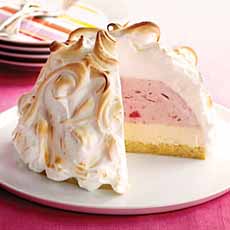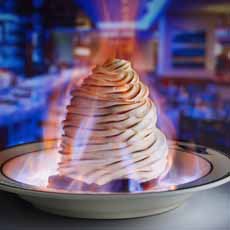Baked Alaska History
An Ice Cream Cake Elevated To A High Peak
CAPSULE REPORT: You don’t have to wait for February 1st, National Baked Alaska Day, to make this dazzling dessert. With store-bought ice cream and pound cake, it’s easy to make any day of the year.
Baked Alaska Overview & History
Baked Alaska is a masterpiece of chemistry: an ice cream cake topped with meringue and baked in the oven until the meringue browns. (Yes, frozen ice cream is baked in an oven!)
The concept (and execution) is simple. Ice cream, mounded on a pie plate or in a rectangle, is covered on all sides with slices of sponge cake or pound cake; this is then covered with meringue. The entire dessert is then placed in a 500°F oven just long enough to firm the meringue—three or four minutes. The meringue is an effective insulator, and in the short cooking time needed to finish the dessert, it prevents the frozen ice cream from melting in the hot oven.
The concept of baked ice cream was developed by the Chinese, who used pastry as the insulator; a Chinese delegation introduced it to Paris in the nineteenth century. In 1804, the American physicist Benjamin Thompson (Count Rumford) then investigated the heat resistance of beaten egg whites, and demonstrated that beaten egg whites were a better insulator.
Thompson’s dish was named Omelette Surprise or Omelette à la Norvégienne, the Norwegian attribution owing to the “arctic” appearance and cold center. Delmonico’s Restaurant in New York City renamed it named Baked Alaska in honor of the newly acquired Alaska territory, and the name stuck.
Make a Baked Alaska with this recipe (it’s easy when you use store-bought ice cream and pound cake instead of making/baking your own from scratch).
Continue To Page 2: Baked Alaska Recipe

It’s much easier to make than you think! Photo by Sergey Kashkin | IST.

| 




